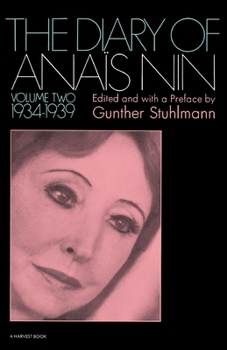Book Overview
Beginning with Nin's arrival in New York, this volume is filled with the stories of her analytical patients. There is a shift in emphasis also as Nin becomes aware of the inevitable choice facing the artist in the modern world. "Sensitive and frank...[Nin's] diary is a dialogue between flesh and spirit" (Newsweek). Edited and with a Preface by Gunther Stuhlmann; Index.
Format:Paperback
Language:English
ISBN:0156260263
ISBN13:9780156260268
Release Date:March 1970
Publisher:Houghton Mifflin
Length:372 Pages
Weight:0.82 lbs.
Dimensions:0.9" x 5.6" x 8.5"
Customer Reviews
2 ratings
A coherent extension of the first volume
Published by Thriftbooks.com User , 20 years ago
Anais Nin began a letter to her father, on the ship that carried her, her mother and brothers, away from him, away from Europe and to New York City. She was 11 at the time. The letter was never sent (her mother did not think it appropriate), but instead developed into a diary that would become legendary by the time she reached her late 20s. Henry Miller helped feed the legend by stating that, once published, Anais Nin's diary would take its place beside the great literary revelations of the century. Upon publication in the 1960s, many critics, and audiences alike, felt that the acclaim was justified. Though original plans called for the publication of only one volume, demand was so great that seven volumes in all would be eventually be published; then, of course, the "unexpurgated" versions would be published in the late 1980s and early 1990s. In the first volume of the diary, we meet Anais Nin living outside of Paris with her husband, banker Hugh Guiler. She has just published her study of DH Lawrence and is about to meet Henry Miller and his fascinating and dramatic wife, June. All characters from the previous volume factor into this second installment, but many new people are introduced. Gonzalo, a Peruvian Marxist, and his wife Helba, are the most interesting new characters. Famous Freudian analyst Otto Rank is also depicted. Anais works with Rank in New York; she struggles to understand whether she is meant to be an analyst or a writer. Yes, in what strikes me as an odd occurence, Anais Nin - with no formal training - is allowed to take on patients. Of the first two volumes, I'd have to say that this is my favorite. There is more movement, and with World War II as a backdrop, there is more social conscience on display. "Politics, all of them," Anais writes in an astute observation that, sadly, is still true 70 years later, "seemed rotten to the core and all based on economics, not humanitarianism." Indeed, in this volume Anais seems more aware of the world around her and less preoccupied with herself, well, a little less so. But, as with all other volumes in this series of diaries, and just about all of Anais Nin's literature, the reader is wise to look more for poetic truth than literal reality. What I mean is, the diaries of Anais Nin are most likely not verbatim transcriptions of the manuscript versions (the difference between this original series and the unexpurgated versions pretty much proves this point). They are something closer to being stylized, masterfully edited "memory books" and persona self-creation. But it's an entertaining, romantic, and often beautiful persona. Andrew Parodi
Anais is always searching
Published by Thriftbooks.com User , 21 years ago
This book has so much wisdom. I find myself reading it very slowly to stop and really think about what she has to say. This volume of her diary is more disconnected than the one prior, but the insight is much more profound.






